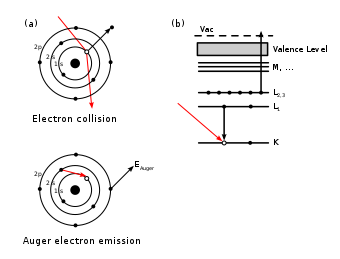Auger effect

The Auger effect (
When a core electron is removed, leaving a vacancy, an electron from a higher energy level may fall into the vacancy, resulting in a release of energy. For light atoms (Z<12), this energy is most often transferred to a valence electron which is subsequently ejected from the atom.[2] This second ejected electron is called an Auger electron.[3] For heavier atomic nuclei, the release of the energy in the form of an emitted photon becomes gradually more probable.
Effect
Upon ejection, the
Auger electron spectroscopy involves the emission of Auger electrons by bombarding a sample with either X-rays or energetic electrons and measures the intensity of Auger electrons that result as a function of the Auger electron energy. The resulting spectra can be used to determine the identity of the emitting atoms and some information about their environment.
The Auger effect can impact biological molecules such as DNA. Following the K-shell ionization of the component atoms of DNA, Auger electrons are ejected leading to damage of its sugar-phosphate backbone.[4]
Discovery
The Auger emission process was observed and published in 1922 by Lise Meitner,[5] an Austrian-Swedish physicist, as a side effect in her competitive search for the nuclear beta electrons with the British physicist Charles Drummond Ellis.
The French physicist
See also
- Auger therapy
- Charge carrier generation and recombination
- Characteristic X-ray
- Coster–Kronig transition
- Electron capture
- Radiative Auger effect
References
- ISBN 978-0-12-091650-4.
- PMID 28397587.
- S2CID 121637546.
- ^ P. Auger: Sur les rayons β secondaires produits dans un gaz par des rayons X, C.R.A.S. 177 (1923) 169–171.
- S2CID 229164774.
- ^ Burhop, E. H. S (1952-01-01). The Auger effect and other radiationless transitions (Cambridge monographs on physics). University Press.
- ISBN 978-0-12-169850-8.
